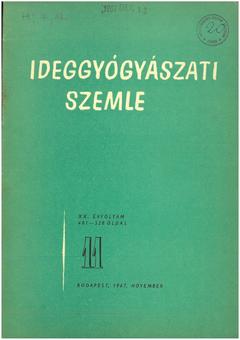The eLitMed.hu medical portal uses computer cookies for convenient operation. Detailed information can be found in the Cookie-policy.
Clinical Neuroscience - 1967;20(11)
Content
[Study of brain surface cooling in patients with epilepsy]
[In patients with epilepsy during surgical exploration, surface cooling of the brain was performed with cold physiological kitchen salt during ECOG registration. 1. A gradual decrease in the amplitude of ECOG activity with insignificant or mild changes in frequency was observed after local surface cooling. No progressive development of slow waves was observed. 2. One to two minutes of brain surface cooling can temporarily suspend the electrical activity of a highly active epileptic focus. 3. The cooling test provides the possibility to determine the primary or secondary nature of the abnormal electrical activity in the opposite homologous area 4. Very brief (10-20 sec) cooling causes a transient increase in epileptiform activity, exclusively at active points. 5. Short brain surface cooling during ECOG could be considered as a new functional electrographic test. It is a very simple and harmless way of amplifying epileptiform activity of uncertain value and thus facilitating localisation of areas of increased excitability. ]
[Data on the role of psychic induction in the generation of compulsions ]
[In five case studies, the authors analyse the role of psychic induction in the generation of compulsions. ]
[Apparently sex-linked inheritance of Huntington's chorea ]
[The analysis of the family tree does not overturn the classic theory that the dominant inheritance of an autosomal gene is responsible for the transmission of Huntington's disease. Such a distribution of the sexes could be produced by the random dispersal of an autosomal dominant gene. Actio of modifier genes is also possible. A simple factor localised in the ivari chromosome, as in the case of haemophilia or colour blindness, is not indicated by the pedigree. However, the exclusivity of females and the relatively high number of males with no survival, makes it conceivable that the same gene that causes chorea in females has a lethal effect in males. It is likely that in this family, sex represents a genetic background that influences the physiologic circumstances of the action of the involved genes in profound ways. However, our observations are not sufficient to unambiguously clarify the inheritance pathway in this family. ]
[Cerebral radiocirculography]
[The authors give a brief overview of the different methodologies for the study of the cerebral circulation with radioactive isotopes. They discuss in more detail Eichhorn's radiocirculography method, which, in addition to its simplicity, provides valuable data on the cerebral circulation.]
[Treatment of childhood organic cerebral lesions and cerebral dysfunction with Mydeton]
[Mydetone has been tested - at an average daily dose of 0.3 gr (3 x 2 tbl) - in 120 children with organic cerebral damage and cerebral function disorders. 21 patients (18%) became symptom-free or improved to a great extent, 87 patients (72%) improved, 12 patients (10%) unchanged. Experience to date has shown that Mydetone is a useful aid in natal and postnatal forms of aperture. It has been shown to be effective in epileptics when used as an adjuvant. And in paroxysmal atypical seizures, it seems to have a particularly good effect. Very useful in memory and attention disorders, learning problems. It is also an effective and useful aid - for emotional and vegetative symptoms of neurotic reactions that are not too acute, as well as for headaches. In cases of enuresis nocturnes, no significant effect was observed. With regard to the mechanism of action of Mydetone, it also draws attention to temporal lobe function changes inextricably linked to the formatio reticularis, based on the effect observed in memory disorders and electrophysiological observations. ]
[Congress of the German Neurosurgical Society 1967]
[Author reports on the 1967 Congress of the German Neurosurgical Society.]
1.
Clinical Neuroscience
[Headache registry in Szeged: Experiences regarding to migraine patients]2.
Clinical Neuroscience
[The new target population of stroke awareness campaign: Kindergarten students ]3.
Clinical Neuroscience
Is there any difference in mortality rates of atrial fibrillation detected before or after ischemic stroke?4.
Clinical Neuroscience
Factors influencing the level of stigma in Parkinson’s disease in western Turkey5.
Clinical Neuroscience
[The effects of demographic and clinical factors on the severity of poststroke aphasia]1.
2.
Clinical Oncology
[Pancreatic cancer: ESMO Clinical Practice Guideline for diagnosis, treatment and follow-up]3.
Clinical Oncology
[Pharmacovigilance landscape – Lessons from the past and opportunities for future]4.
5.



